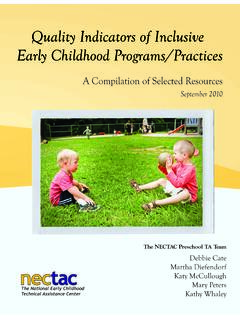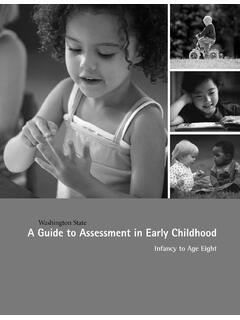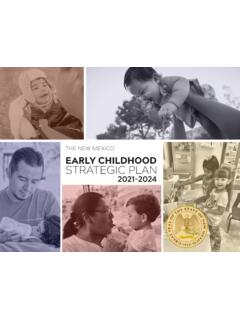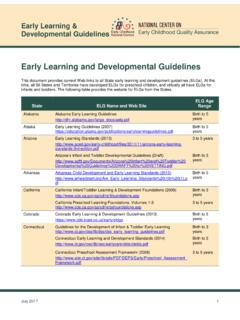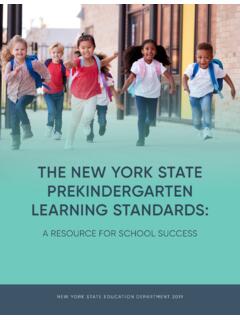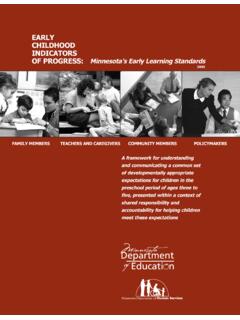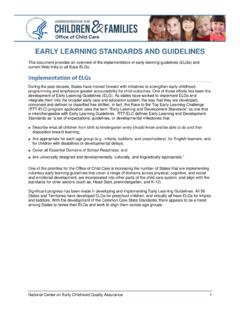Transcription of Michigan Department of Education Early Childhood to …
1 SEL competencies and Indicators - 2017 1 Michigan Department of Education Michigan Department of Education Early Childhood to Grade 12 Social and Emotional Learning (SEL) competencies and Indicators Currently, Michigan has Content State Standards that focus on academics. However, there is little that attend to the other aspects of learning for children/students. SEL competencies help complete the academic process for all youth, infants to school-aged, through graduation. In combination with the Michigan Health Education Standards, SEL competencies help support a well-rounded Education that teaches to the whole child. When caregivers and schools focus on the development of the whole child, utilizing SEL competencies to guide instruction and interactions with children and students, academic achievement improves, as well as the skills needed for college and career readiness.
2 Furthermore, a focus on SEL helps create an environment that enables teachers to teach and students to learn which research shows is necessary for school and life success. SEL Competencies1 Self-awareness: The ability to accurately recognize one s emotions andthoughts and their influence on behavior. This includes accurately assessingone s strengths and limitations and possessing a well-grounded sense ofconfidence and optimism. Self-management: The ability to regulate one s emotions, thoughts, andbehaviors effectively in different situations. This includes managing stress,controlling impulses, motivating oneself, and setting and working towardachieving personal and academic goals. Social awareness: The ability to take the perspective of and empathize withothers from diverse backgrounds and cultures, to understand social andethical norms for behavior, and to recognize family, school, and communityresources and supports.
3 Relationship skills: The ability to establish and maintain healthy andrewarding relationships with diverse individuals and groups. This includescommunicating clearly, listening actively, cooperating, resisting unwanted orinappropriate social pressure, negotiating conflict constructively, and seekingand offering help when 1 Collaborative for Academic, Social, and Emotional Learning. (2015). Social and emotional learning core competencies . Chicago, IL: Author. Retrieved from SEL competencies and Indicators - 2017 2 Michigan Department of Education Responsible decision making: The ability to make constructive and respectful choices about personal behavior and social interactions based on consideration of ethical standards, safety concerns, social norms, the realistic evaluation of consequences of various actions, and the well-being of self and others.
4 SEL competencies and Indicators - 2017 3 Michigan Department of Education Michigan Department of Education (MDE) Early Childhood -Grade 12 Social and Emotional Learning (SEL) competencies and Indicators competencies Indicators Self-Awareness 1A. Demonstrate an awareness of their emotions 1B. Demonstrate an awareness of their personal traits, including their strengths and interests 1C. Demonstrate awareness of their external supports 1D. Demonstrate a sense of personal responsibility Self-Management 2A. Identify and manage their emotions and behavior constructively 2B. Demonstrate honesty and integrity 2C. Set, monitor, adapt, and evaluate goals to achieve success in school and life Social Awareness 3A. Demonstrate awareness of other people s emotions and perspectives 3B.
5 Demonstrate consideration for others and a desire to positively contribute to the school and community 3C. Demonstrate an awareness of different cultures and a respect for human dignity 3D. Can read social cues and respond constructively Relationship Skills 4A. Use positive communication and social skills to interact effectively with others 4B. Develop and maintain positive relationships 4C. Demonstrate an ability to prevent, manage, and resolve interpersonal conflicts in helpful ways Responsible Decision Making 5A. Uses personal, ethical, safety, and cultural factors in making decisions 5B. Develop, implement, and model effective decision-making skills to deal responsibly with daily academic and social situations 5C. Play a developmentally appropriate role in classroom management and positive school climate SEL competencies and Indicators - 2017 4 Michigan Department of Education Definition: Social Emotional Learning (SEL) is the process through which individuals learn to recognize and manage emotions, care about others, make good decisions, behave ethically and responsibly, develop positive relationships, and avoid negative behaviors.
6 Within the child s natural environment and/or school setting, SEL can best be accomplished through a layered approach of skills lessons taught through the curriculum and infused into the environment including safety, respect, and caring. Research base: A context that supports the basic personal, social, and intellectual needs of students is critical for success in school1. Research confirms that a focus on SEL improves students social, emotional, and academic skills. In a meta-analysis of 213 studies evaluating SEL programs/interventions, Durlak and Colleagues (2011)2 found that, compared with students receiving standard Education without SEL, students receiving interventions designed to promote social and emotional development demonstrated increased academic achievement and positive social behaviors, and showed decreased conduct problems and emotional distress.
7 Students receiving SEL interventions also showed improved social-emotional skills. The meta-analysis revealed that students with SEL training gained 11 percentile points on average in test scores and similar gains in grades relative to students not in a SEL program. These results were consistent across grade level (elementary, middle, and high schools), location (urban, rural, and suburban), and school type (schools serving ethnically and racially diverse student populations). Durlak and his colleagues also found that the effects of SEL programs were stronger when programs were implemented well and completely, , with fidelity , underscoring the importance of teacher training and ongoing professional development. What is in the MDE SEL competencies and Indicators This document presents five core competencies related to social and emotional learning, and includes a rationale for each.
8 The Early Childhood competencies found within the SEL competencies come from State Board of Education (SBE) approved standards. The Office of Great Start has produced three sets of standards. The Early Childhood Standards of Quality for Infant and Toddler Programs (ECSQ-IT), Early Childhood Standards of Quality for Prekindergarten (ECSQ-PK), and the Michigan Out-of-School Time (MOST) Standards of Quality. A fourth document, Early Childhood Standards of Quality for Kindergarten through Third Grade, is in development. The abbreviated portion of the SBE approved SEL Standards for Early Childhood are linked with the K-12 SEL competencies to offer a continuum of these skills for all youth. For each SEL competency, 3-4 indicators are identified, followed by benchmarks organized by age band.
9 For each benchmark there are suggested strategies for caregivers and 1 Solomon, D., Battistich, V., Watson, M., Schaps, E., & Lewis, C. (2000). A six-district study of educational change: Direct and mediated effects of the child development project. Social Psychology of Education , 4, 3-51. 2 Durlak, , Weissberg, , Dymnicki, , Taylor, , & Schellinger, (2011). The impact of enhancing students social and emotional learning: A meta-analysis of school-based universal interventions. Child Development, 82, 405-432. SEL competencies and Indicators - 2017 5 Michigan Department of Education teachers; these activities are designed to promote SEL skills in a caregiving and/or classroom setting. They are not intended to be an exhaustive list of activities.
10 These competencies , indicators, and strategies were developed through the collaborative effort of representatives from every office in MDE, and in collaboration with national experts from the Great Lakes Comprehensive Center (GLCC), the Center on Great Teachers and Leaders (GTL Center), and the Collaborative for Academic, Social, and Emotional Learning (CASEL). Note: These competencies and indicators are emerging and build on one another. They were formatted to delineate the progression of one skill to another as the child/student continues to grow developmentally. Caregivers/Teachers may need to revisit earlier skills periodically in working with various children and students as not all development is linear but can also be cyclical. Therefore, it does not mean that if a child/student has not accomplished an indicator at a developmental benchmark they have a deficit or need remediation.










